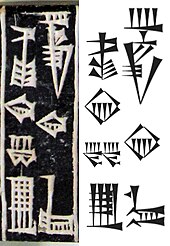
Back ملك سومر وأكد Arabic Βασιλεύς του Σουμέρ και του Ακκάδ Greek Rey de Sumeria y Acad Spanish شاه سومر و اکد Persian Re di Sumer e Akkad Italian 수메르와 아카드의 왕 Korean Rei da Suméria e Acádia Portuguese Sümer ve Akad kralı Turkish


King of Sumer and Akkad (Sumerian: 𒈗𒆠𒂗𒄀𒆠𒌵 lugal-ki-en-gi-ki-uri[2], Akkadian: šar māt Šumeri u Akkadi)[3] was a royal title in Ancient Mesopotamia combining the titles of "King of Akkad", the ruling title held by the monarchs of the Akkadian Empire (2334–2154 BC) with the title of "King of Sumer". The title simultaneously laid a claim on the legacy and glory of the ancient empire that had been founded by Sargon of Akkad (r. 2334–2279 BC) and expressed a claim to rule the entirety of lower Mesopotamia (composed of the regions of Sumer in the south and Akkad in the north). Despite both of the titles "King of Sumer" and "King of Akkad" having been used by the Akkadian kings, the title was not introduced in its combined form until the reign of the Neo-Sumerian king Ur-Nammu (c. 2112–2095 BC), who created it in an effort to unify the southern and northern parts of lower Mesopotamia under his rule. The older Akkadian kings themselves might have been against linking Sumer and Akkad in such a way.
In later centuries of Mesopotamian history, when the major kingdoms were Assyria and Babylon, the title was mostly used by monarchs of Babylon since they ruled lower Mesopotamia. For Assyrian kings, the title became a formal assertion of authority over the city of Babylon and its surroundings; only those Assyrian rulers who actually controlled Babylon used the title and when Assyria permanently lost control of Babylon to the Neo-Babylonian Empire, the rulers of that empire began using it instead. The final king to claim to be the King of Sumer and Akkad was Cyrus the Great (r. c. 559–530 BC) of the Achaemenid Empire, who assumed several traditional Mesopotamian titles after his conquest of Babylon in 539 BC.
- ^ Edzard 2003, p. 36.
- ^ Maeda 1981, p. 4.
- ^ Da Riva 2013, p. 72.